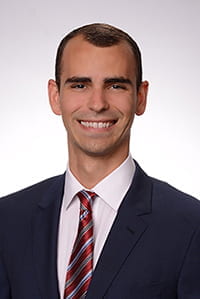
I was in an operating room at the Montreal Neurological Institute when I received the invitation to interview at WashUy. Still in the OR, my research mentor started telling me all about Dr. Michael Avidan and the ambitious projects that he and his team were pioneering at Wash U. Two months later, I was sitting in Dr. Avidan’s office overlooking Forest Park, discussing medicine, anesthesia and Douglas Adams. Considering that he had also undertaken an international move to St. Louis, I asked why he chose Wash U. With his characteristically candid tone, he told me that they weren’t afraid of ambitious and avant-garde ideas at Wash U; in fact, they sought them.
Over the past two years, I’ve experienced what Dr. Avidan meant first-hand. During intern year, I joined an innovative perioperative neuroscience lab lead by Dr. Ben Palanca, and garnered support to launch my first interventional trial. From startup funding, to getting an IRB protocol approved and mobilizing research staff, the support that I received so early was incredible. I was also invited to join ongoing NIH-funded projects, with a level of involvement tailored to my evolving clinical responsibilities. Under the guidance of trusted mentors, these efforts have led to two patents, two publications, and a maturing manuscript pipeline. Even more valuable than academic products is the global network that I’ve been introduced to, with collaborators in North America, Europe, Africa, Asia and Oceania.
As a physician-scientist, balancing research with clinical training during residency is at the forefront of my mind. We have four years to grow into world-class clinical anesthesiologists, which requires diligent work and study. Training at a fully integrated medical center with adult and pediatric anesthesiologists, intensivists and scientists all working together on the same campus has been instrumental in maintaining this balance. Many of the patients we care for are enrolled in clinical trials, whether it be a novel oncology regimen, emerging surgical procedure or innovative perioperative protocol. The Division of Clinical and Translational Research is a short walk from any given ICU or operating room on campus, so stopping by the lab is as easy as a bathroom break. There is also a deep culture of respect for the clinical responsibilities of residents in the department, and faculty mentors have always prioritized my development as a physician while supporting my scientific endeavors. Over the course of CA-1 year, I have personally cared for over 400 patients requiring anesthesia, including 5 liver transplants, 30 procedures on cardiopulmonary bypass, and over 100 pediatric cases. I expect to surpass the ABA requirements for graduation before reaching the midway point of CA-2.
It’s also worth mentioning out-of-hospital balance. My wife and I couples-matched, and we had never been to St. Louis before our interviews. Coming from Canada, we were concerned about proximity to nature and cost of living. Naturally, we were pleased to find that there is an enormous public park neighboring the medical center, full of free activities. We often run and cycle around the park with colleagues and visit exhibits at the Saint Louis Art Museum. We’ve also been exploring the surrounding horse and wine country, as well as hiking trails in state parks and national forests. Our cost of living is actually lower than what it was in Canada, allowing us to live and travel comfortably on resident salaries.
Why choose WashU? The science and practice of anesthesiology is still comparatively young, and the landscape of healthcare is evolving at an accelerating pace. If we intend to lead perioperative medicine for decades to come, then we should train at institutions that embrace change as an opportunity to innovate. Whether you want to pursue the discoveries that drive our future, or translate and implement them into clinical practice, you can count on WashU to support you.